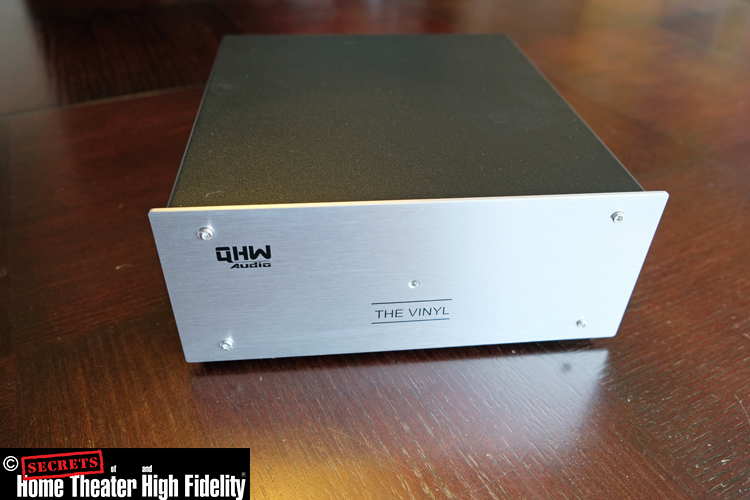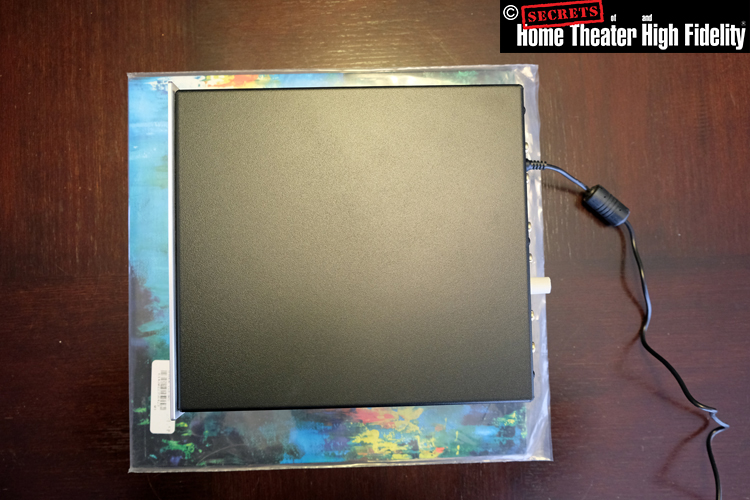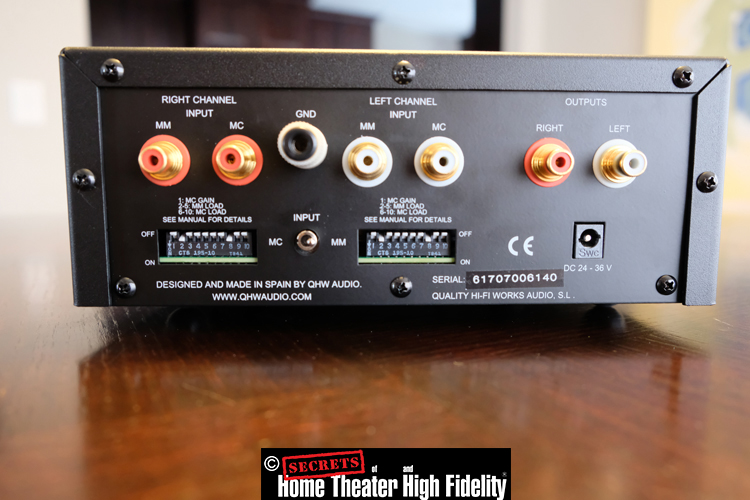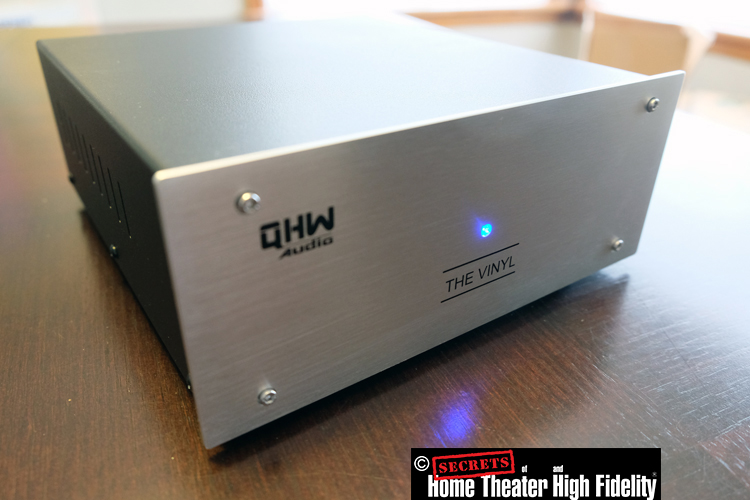“The Vinyl” is an overachiever and quite impressive as the first phono stage for this new kid on the hi-fi block.
QHW “The Vinyl” Phono Preamp Highlights
- Detailed presentation that always grabbed me.
- Excellent build quality.
- Highly adjustable cartridge loading.
QHW (Quality Hi-Fi Works) designs and builds its components in Madrid, Spain. “The Vinyl” is the first phono stage from QHW, and it has been making waves throughout the industry.
Design:
Combination MM/MC external phono stage.
Nominal gain at 1 KHz:
MM: 42 dB
MC low: 63 dB
MC high: 69 dB
Maximum output level:
9 V RMS or more.
MM input impedance:
47 KOhm
MM input capacitance:
Adjustable from 47 pF to 617 pF.
MC input impedance:
Adjustable from 47 Ohms or less to 47 KOhms.
MC input capacitance:
150 pF.
Total harmonic distortion at 1 KHz, 2 V RMS output, 10 KOhms load (20 HZ – 20 KHz band):
MM: 0,001 % or less.
MC low: 0,001 % or less.
RIAA deviation 20 Hz – 20 KHz:
Less than ± 0,1 dB.
Residual noise:
< 300 uV (MC input shorted).
Signal-to-noise ratio:
MM: -84 dB or better (input shorted, referred to 2 V RMS).
MM: -96 dB or better (input shorted, referred to maximum output).
MC low: -78 dB or better (input shorted, referred to 2 V RMS).
MC low: -90 dB or better (input shorted, referred to maximum output).
Crosstalk:
< -96 dB (at 1 KHz referred to 2 V RMS output in other channel).
Power consumption:
< 10 W
Power supply:
Output, 36 V DC, input 100 V – 240 V AC 50 – 60 Hz.
Maximum dimensions:
243 mm (L) x 218 mm (W) x 89 mm (H) (including connectors and feet).
Weight:
2 kg
MSRP:
$890
Website:
SECRETS Tags:
QHW, phono stage, phono preamp
“The Vinyl” is a little bigger in real life than I was expecting from the photos.
The proportions are quite handsome, in fact. The front face plate is not as thick as you might find on components that aspire to the ‘high-end’ look but it’s hardly a factor – especially when installed on a shelf. The blue LED is pretty bright by modern standards – for a while I thought a full moon was lighting up my basement home theater room. Behind the face plate is sturdy sheet metal with a lustrous black finish. The feet are soft, rounded rubber. The weight is satisfyingly hefty, especially considering that the power supply is external.
That external power supply is not a wall wart – it’s a cord worm?! No! “Power brick”. Ok, fine. No matter what you call them, external power supplies are a big plus for phono stages which are dealing with small signals. I find that wall warts will usually take up too much space on a power strip or power conditioner – blocking the use of the adjacent outlet so score one more for this power supply but then take one off – the connection for the AC side of the power brick is an IEC C7 – two prongs, no ground. This will present some obstacles to those looking to use an upgraded power cord. It is possible, Shunyata (for instance) makes a C15 to C7 adapter as well as a Venom cord already terminated with a C7 connector. AudioQuest has a C7 power cord as well. I managed to get a C15 to C7 adapter from Amazon and tried a few power cords – see below.
Secrets Sponsor
The connection from the power brick to “The Vinyl” is of the standard sort for DC power supplies, plus in the middle, ground on the outside. This made me think about the possibilities for upgraded external supplies for The Vinyl. In this case, though, the DC supply is 36V. This could be hard to find. The owner’s manual states that the supply can be in the range of 24-36V (and must be able to supply 1A). There is also the obligatory warning about using anything other than the provided supply and of course, you should know what you’re doing if you try a different one. Note that QHW Audio is contemplating the release of an optional, upgraded power supply for The Vinyl. Power supply regulation is used internally, which does make whatever is going on externally less of an issue – but my experience is that there is still improvement to be found with better external supplies.
From a user’s point of view, “The Vinyl” is two phono stages in one box. One for MM (moving magnet) and one for MC (moving coil). The back panel has a set of inputs for each type. A central switch (on the rear panel) is used to select which input will be amplified and sent to the single set of outputs so you could have two arm-cartridge combinations plugged in and select between them. All connections are single-ended. The ground lug is nicely sized and will accept a banana plug, spade, or bare wire. There is no power switch. “The Vinyl” should remain powered up all the time.
The gain for the MM inputs is fixed at 43db. The MC inputs can be amplified to 63 or 69db – pretty big numbers. In my experience 60-63db is enough for a low-output MC cartridge but what if you have a high-output MC? There are plenty of these available. Indeed, my Dynavector DV-20XH is one such example. The output of this MC cart is 2.8mV, about half of the expected output of an MM cartridge but clearly in the same ballpark. I have used 45-55db gain with other phono stages connected to this cartridge. In this case, using 63db, my initial impression was that some clipping was happening somewhere in the system.
This was using my Simaudio 430HA as the preamp. The 430 has a switch to select between 14 and 20dB of gain. I switched it to ‘low’ and had no further issues. We should note that you are very unlikely to have such an issue – the oddball in my experience was the ‘20’ number from the high setting on the 430HA, this is there in order to drive certain headphones, a regular preamp will not have such gain. Another option would be to just go ahead and use the MM inputs on “The Vinyl.” Most high-output MC cartridges are designed for use with an MM phono stage anyway. And often, there is only the typical, 47kOhm load available. Indeed, I had this high-output MC cartridge plugged into my DIY Pass Labs Pearl One phono stage with its default loading of 47kOhms for many years and was very happy. That phono stage eventually gave up the ghost, likely due to my lack of soldering skills.
I stuck with the MC inputs on “The Vinyl,” however, for presumably more-optimal loading. For the MC inputs the capacitance is fixed at 150pf. For the MM, capacitance can be adjusted from 0 to 517pf. The input impedance for MM is fixed at 47kOhm. For MC the resistive loading is highly adjustable. A range of values: 47kOhm, 1kOhm, 470Ohm, 100Ohm, 47Ohm, and 10Ohm can be achieved by setting one of the 5 provided DIP switches ON with the others OFF (the owner’s manual clearly specifies which switch to set to ON). However, many other load values are possible. In a welcome, bold move, the manual provides an equation to use to calculate the load when two switches are set to ON. The formula is simply that for two resistors in parallel: the product of the two selected values divided by the sum:
R1 * R2 / R1 + R2
For my better cartridge, the Dynavector XX2 Mk2, the recommended resistance load is >30 Ohms. I typically set it to 33 Ohms with my Moon 810LP. Using “The Vinyl,” I toggled the switches for the 100- and 47-Ohm settings and if your math matches mine you would say that is 32 Ohms which is certainly close enough for rock-n-roll.
The manual for “The Vinyl” states that the maximum output is ‘9V RMS or more’. That’s a funny way to specify a maximum but in any case, 9V is a lot. However, it is simply a reflection of the 36V power supply, it does not mean that a real-world cartridge would drive enough voltage to create that level on the outputs of “The Vinyl.”
Secrets Sponsor
The RIAA curve is achieved in the feedback network attached to the discrete operational amplifier designed by QHW – the AE2270. This keeps the overall circuit as simple as possible.
A note on the distortion specs – while writing this review the founder of QHW, Francisco Vizcaya, informed me that the newest distortion measurements (which were not yet on the QHW website) showed .001% THD (1kHz, 10kOhm load), the previous figure was .004%. This new report is possible due to an upgrade of their measurement equipment. I get the impression that QHW is an enterprise that takes hi-fi seriously. “The Vinyl” went through numerous design revisions, each of them graded by a listening group that was sequestered in an acoustically treated room for hours-long listening sessions. Presumably with appropriate refreshments and potty breaks. They compared all manner of internal circuit variations including such things as through-hole vs surface mount for the components. The determination on that one was that the traditional through-hole mounting was preferred in at least one case – the BJT transistors handling the small signals from MC cartridges.
While we’re on the subject of design – two other phono stages are in development at QHW, one less expensive than “The Vinyl” and one higher-priced. I’m as curious about the sound of these new components as I am about the names they will eventually have. “The Vinyl” is “The Vinyl,” where do you go from there?
The word from Francisco was that “The Vinyl” didn’t need much break-in but a 24-hour warm-up was beneficial. I found this to be the case.
I started with “The Vinyl” in my home theater system – which until recently used an Arcam AV8 as a preamp feeding only two channels of a Parasound Halo A51 and driving my vintage Gold Sound kit speakers. These are a three-way design similar to the JBL L100 but with 15” woofers. Recently the JBL midranges have been upgraded to Purify PTT6.5X08-NFA-01 6.5″ Woofers. Similarly, the old Morel tweeters (which long ago lost the ferrofluid that is meant to keep them cool) have been replaced with Satori Beryllium dome tweeters. All these new parts were purchased from Madisound. I am their new best friend.
I had to remove the AV8 from the system as the left channel has gone the same way as the ferrofluid in the old tweeters. In this case, the issue is/was some over-enthusiastic design specs on certain interconnects and the RCA connections on the Arcam. It’s good if the connections are tight, right? Until you want to try a different wire. Sigh.
So, the preamp role in this system is now performed by a Simaudio Moon 430HA. The Sim is ever so slightly darker and a bit smoother than the Arcam which I very much liked in spite of its swollen RCA connectors.
First impression of “The Vinyl”: Wow. As is the usual case with most any hi-fi these days there is nothing much to say about extension – bass is great, treble is great, and no discernable peaks anywhere in between. I can add that bass is nicely rounded and tuneful. Low notes sound like notes, different from each other. The instruments and voices are all well separated from each other. This downstairs system is not an imaging champ, but “The Vinyl” did an admirable job of putting the band(s) out front and centered. With the high affordability factor of “The Vinyl” I had to ask myself: What price would I have guessed if I didn’t already know – $1500 to $2000 is my estimate of what I would have guessed (that’s a mouthful so add salt as needed). The soundstage in my main system, where imaging happens more readily, was good. It didn’t go beyond the speakers or behind them, but it wasn’t flat either – there was a little extension into the room.
The main system is amplification by Simaudio (usually using the Moon 810LP phono stage), connected by Kimber 8TC to Daedalus speakers. Interconnects in the analog chain are balanced Nordost Tyr. Power cables are Shunyata of different generations, plugged into a Furman IT-Reference 20i. All records are cleaned with an Audio Desk Systeme Pro Vinyl cleaner. The cartridge is a Dynavector XX2-Mk2. Since “The Vinyl” has only single-ended outputs I used the Nordost Blue Heavens to connect to the Moon P-8 preamp which in turn, drives Moon W-6 monoblocks.
In this system, with lots of resolving power, “The Vinyl” was still impressive. Sure, it is a step or two down from the twenty-one times more expensive Moon 810LP but not twenty-one steps down as the price difference might suggest. This is the nature of vinyl playback systems; you don’t have to spend a fortune to have something that you could enjoy forever.
I’ve been struggling to characterize the difference between these two preamps or perhaps just struggling to describe the sound of “The Vinyl” in general. For lack of a better way to put it, “The Vinyl” leans towards the sort of sound MM cartridges produce, even when it is fed with an MC. What sort of difference is that? Good MM cartridges have a bold presentation that will grab you, and wow you, like a tight, loud brass section or piano played with fortissimo. MCs produce their electrical signal by moving small, lightweight coils instead of heavy magnets and so usually reveal more of the intricacies of plucked strings, vocals, and how a drumhead or cymbal sounds when struck. Neither is right or wrong, it’s just their nature. The problem with my description so far is that it might give the impression that “The Vinyl” misses some of the nuances of what is in your grooves and that is not the case at all, it’s just a matter of how it all comes across.

Spiritualized “Pure Phase”
I’m sticking with my theory that for long-lived bands with an accomplished discography, the record right in the middle of the list is the most interesting, pivotal, and often the best. But for Spiritualized I’m combining the output of Spaceman 3 and Spiritualized. Why? Spiritualized is simply a rotating group of players in support of J. Spaceman (Jason Pierce). Spaceman 3 was Jason’s previous band, and the evolution is clear.
Ok, this math is easier than calculating parallel resistors, four Spaceman 3 records plus nine (and counting) Spiritualized discs make 13… divide by 2… could be 6 or could be 7… BOOM, my theory is working great! Take your pick between Pure Phase and Ladies and Gentlemen We Are Floating in Space. I think we have to go with Ladies and Gentlemen as the pinnacle (though the later album Songs in A&E deserves some special mention) but Pure Phase might be the most interesting. As Flesh and Blood is to Avalon or Amnesiac is to Kid A, Pure Phase presents a slightly stripped-down version of the sort of tunes on Ladies and Gentlemen We Are Floating in Space. Demos as opposed to fully realized masterpieces. If I’m listening to Pure Phase, that’s my favorite, if I’m listening to Ladies and Gentlemen, well, it is a masterpiece.
The recent re-issue of Pure Phase made this clear to me and “The Vinyl” masterfully rendered the more-clear and more-bold mix in the new version. The 1995 original sounds great, the reissue is greater. So, what were the differences in this case? The original has less of everything (bass, treble, dynamics) with some blur between instruments. But if it was all we had, we’d still say it is a great album. The new version pumps up each of the many instruments and vocals and puts them back together in a clearer and very dynamic fashion. Everything stands out. I heard tremolo and warbles and even whole guitar lines that went by unnoticed while playing the original. “The Vinyl” loved to parse these complex tracks and make them rock. It grabbed the new version and spiked it in my living room. “Give me more”, said “The Vinyl.” So, I did.

Ganser “Just Look at that Sky”
The intelligence, artificial or otherwise that makes the recommendations on YouTube knows what I like. Ganser is a Chicago band described on their own website as ‘post-punk, no wave’. I could go with that, but my description is that they sound like Andy Bell (the one from Ride and Oasis) playing lead guitar for the Pretenders. Intricate, inventive guitar with an edge as part of a power trio and a growly female singer. The bold presentation of “The Vinyl” is perfect for this music. “The Vinyl” could take in the chunky bass in these grooves, roll it around in its mouth (so to speak) and blow cool smoke rings from my speakers. No, I wasn’t on drugs, too old for that. The drums are as featured in the mix as anything else and the power-pop thunder was striking.
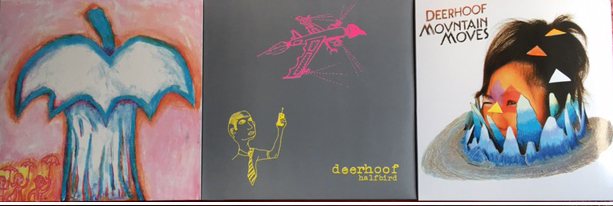
Deerhoof “Various records”
Deerhoof is just amazing. If you’re old like me you remember Missing Persons, made up of musicians who had all played for Frank Zappa – and so had to be able to play anything and everything, flawlessly and fast. Deerhoof is better than those pikers. Seriously. Deerhoof writes songs with complex parts for everyone all at once that I think are beyond most bands’ ability to play. It’s not studio trickery either, they play the same songs live, note for note without breaking a sweat. It’s actually bizarre to watch. They are in their 27th year as a band and their 19th studio album is coming out about now. I have yet to test my discography theory with these guys. I’ll have to acquire more of their records to do that. Playing the Deerhoof records I do have was rock-n-roll heaven with “The Vinyl.” Guitar, bass, drums, and Satomi Matsuzaki’s quirky and occasionally straight-up beautiful vocals were clear and distinct in spite of overwhelming guitar parts sharing some of the same frequencies.
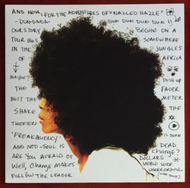
Erykah Badu “Worldwide Underground”
Have I mentioned that Erykah Badu is a genius? I think I have. As noted, I mostly connected “The Vinyl” outputs using Nordost Blue Heavens. I was curious what some other cables might do so I went to my local friendly hi-fi store – Stereotypes Audio in Portland, Oregon – and borrowed some Wireworld Silver Eclipse 8 interconnects. There was a distinct improvement, these wires brought a more open and easy sound. With the Blue Heavens, it seems like “The Vinyl” is having to push through a little bit. Alas, I had to return the Wireworlds so most of my listening was done with the mid-level Nordost cables, but I sampled one of my regulars, Ms. Badu’s “Worldwide Underground“ through “The Vinyl” connected with the Silver Eclipse 8’s. This record features many subtleties and a vast dynamic range. The sound was so good I was floored yet again. I keep thinking that for the price of “The Vinyl,” I should be able to provide a list of flaws. I can’t. This record has many of the sort of details that I thought would make me miss my 810LP, but I did not. I was simply enjoying a wonderful record.
I thought I would be stymied in the power cord department – I have a variety of Shunyata cables on hand but all with C15 or C19 connectors. Not suitable for The Vinyl’s C7 power supply. I managed to find a C15 to C7 adapter on Amazon and proceeded. The adapter doesn’t seem to fit precisely – seems like it should be a little snugger, but the better cords definitely made a difference. This is all part of an experiment that I’ve been pondering for a long time. Does it make sense to spend more on power cords and interconnects than on the components themselves? First data point: Yes. Actually, I think the way to think about this particular data point is that “The Vinyl” is an extreme bargain so maybe it’s an outlier. Anyway, what sort of differences did I hear? I started with a first-generation Shunyata Venom and immediately heard a bit more shimmer to everything. A Venum-HC was very nice, lower noise floor, a more open presentation, wider soundstage. At the height of crazy, I tried a King Cobra CX – even at used prices it costs more than “The Vinyl.” Now this was nice, the noise floor dropped, bass and treble were more defined. As in, “I heard things in the mix that I wasn’t hearing before”. Not subtle differences.

Bjork “Debut”
Listening to Bjork’s “Debut“ was fantastic with this setup – vocals soared above the mix and the leading and trailing edges of every instrument, every note or thump, were revealed. I switched back to the cord that came in the box: still good but closed-in, curbed, by comparison. I did most of my listening with the Venum-HC. If you try this, you will probably not enjoy the poor fit of the C15 to C7 adapter. It hasn’t come loose or anything, it’s just not reassuring, not snug.
“The Vinyl” is a bargain that you won’t regret, leaving you plenty of money to buy reissues of albums you already have (ahem)..
- Unflinching rendering of any record. Complex? Intricate? Bring it on.
- Separate inputs for MM and MC, with a switch to select between them, enabling two tonearms or two record player connections.
- Wide range of cartridge loading options.
- IEC C15 input to the power supply.
- Less-bright LED.
- One more MC gain level – lower than the ones provided.
There’s a local audiophile I know with an extensive, expensive, system including two or three turntables and even more cartridges than turntables. I was hoping to pick up one of his used/unused cartridges. For a while, the answer was ‘yes’. Then, it was ‘no’. Grrrr. After thinking about it, he plans to re-insert that cartridge into his system at some point. Even though he favors the cartridges he is currently using, he wants to listen to the ones he is not using too. This is how it is with an analog system. It is as true for phono stages as it is for cartridges. You can move up, you can get something ‘better’, usually for more money. But you will miss the previous one. At a certain level, it becomes difficult to describe what a component ‘sounds like’ (see above) but you want to listen to it. For me, I want to install “The Vinyl” in my downstairs system so I’m buying the review sample. I could say “Highly recommended for the price” but the better wording is simply: “Highly recommended”.




